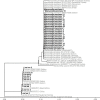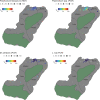Characterising co-infections with Plasmodium spp., Mansonella perstans or Loa loa in asymptomatic children, adults and elderly people living on Bioko Island using nucleic acids extracted from malaria rapid diagnostic tests
- PMID: 35100277
- PMCID: PMC8830708
- DOI: 10.1371/journal.pntd.0009798
Characterising co-infections with Plasmodium spp., Mansonella perstans or Loa loa in asymptomatic children, adults and elderly people living on Bioko Island using nucleic acids extracted from malaria rapid diagnostic tests
Abstract
Background: Regular and comprehensive epidemiological surveys of the filarial nematodes Mansonella perstans and Loa loa in children, adolescents and adults living across Bioko Island, Equatorial Guinea are lacking. We aimed to demonstrate that blood retained on malaria rapid diagnostic tests, commonly deployed for malaria surveys, could be used as a source of nucleic acids for molecular based detection of M. perstans and L. loa. We wanted to determine the positivity rate and distribution of filarial nematodes across different age groups and geographical areas as well as to understand level of co-infections with malaria in an asymptomatic population.
Methodology: M. perstans, L. loa and Plasmodium spp. parasites were monitored by qPCR in a cross-sectional study using DNA extracted from a subset malaria rapid diagnostic tests (mRDTs) collected during the annual malaria indicator survey conducted on Bioko Island in 2018.
Principal findings: We identified DNA specific for the two filarial nematodes investigated among 8.2% (263) of the 3214 RDTs screened. Positivity rates of M. perstans and L. loa were 6.6% and 1.5%, respectively. M. perstans infection were more prominent in male (10.5%) compared to female (3.9%) survey participants. M. perstans parasite density and positivity rate was higher among older people and the population living in rural areas. The socio-economic status of participants strongly influenced the infection rate with people belonging to the lowest socio-economic quintile more than 3 and 5 times more likely to be L. loa and M. perstans infected, respectively. No increased risk of being co-infected with Plasmodium spp. parasites was observed among the different age groups.
Conclusions/significance: We found otherwise asymptomatic individuals were infected with M. perstans and L. loa. Our study demonstrates that employing mRDTs probed with blood for malaria testing represents a promising, future tool to preserve and ship NAs at room temperature to laboratories for molecular, high-throughput diagnosis and genotyping of blood-dwelling nematode filarial infections. Using this approach, asymptomatic populations can be reached and surveyed for infectious diseases beyond malaria.
Conflict of interest statement
The authors have declared that no competing interests exist.
Figures





Similar articles
-
Prevalence, probability, and characteristics of malaria and filariasis co-infections: A systematic review and meta-analysis.PLoS Negl Trop Dis. 2022 Oct 21;16(10):e0010857. doi: 10.1371/journal.pntd.0010857. eCollection 2022 Oct. PLoS Negl Trop Dis. 2022. PMID: 36269701 Free PMC article.
-
Diagnostic performance of capillary and venous blood samples in the detection of Loa loa and Mansonella perstans microfilaraemia using light microscopy.PLoS Negl Trop Dis. 2021 Aug 16;15(8):e0009623. doi: 10.1371/journal.pntd.0009623. eCollection 2021 Aug. PLoS Negl Trop Dis. 2021. PMID: 34398886 Free PMC article.
-
The relationship between microfilaraemic and amicrofilaraemic loiasis involving co-infection with Mansonella perstans and clinical symptoms in an exposed population from Gabon.J Helminthol. 2016 Jul;90(4):469-75. doi: 10.1017/S0022149X15000607. Epub 2015 Aug 13. J Helminthol. 2016. PMID: 26268068
-
Loa loa and Mansonella perstans infections in Ijebu north, western Nigeria: a parasitological study.Jpn J Infect Dis. 2001 Jun;54(3):108-10. Jpn J Infect Dis. 2001. PMID: 11544400
-
[Mansonella perstans filariasis].Parassitologia. 2007 Jun;49(1-2):23-6. Parassitologia. 2007. PMID: 18416002 Review. Italian.
Cited by
-
Development and evaluation of PlasmoPod: A cartridge-based nucleic acid amplification test for rapid malaria diagnosis and surveillance.PLOS Glob Public Health. 2023 Sep 27;3(9):e0001516. doi: 10.1371/journal.pgph.0001516. eCollection 2023. PLOS Glob Public Health. 2023. PMID: 37756280 Free PMC article.
-
Nodding syndrome, a case-control study in Mahenge, Tanzania: Onchocerca volvulus and not Mansonella perstans as a risk factor.PLoS Negl Trop Dis. 2023 Jun 20;17(6):e0011434. doi: 10.1371/journal.pntd.0011434. eCollection 2023 Jun. PLoS Negl Trop Dis. 2023. PMID: 37339148 Free PMC article.
-
Prevalence, probability, and characteristics of malaria and filariasis co-infections: A systematic review and meta-analysis.PLoS Negl Trop Dis. 2022 Oct 21;16(10):e0010857. doi: 10.1371/journal.pntd.0010857. eCollection 2022 Oct. PLoS Negl Trop Dis. 2022. PMID: 36269701 Free PMC article.
References
-
- Mourembou G, Fenollar F, Lekana-Douki JB, Ndjoyi Mbiguino A, Maghendji Nzondo S, Matsiegui PB, et al.. Mansonella, including a Potential New Species, as Common Parasites in Children in Gabon. PLoS neglected tropical diseases. 2015;9(10):e0004155. doi: 10.1371/journal.pntd.0004155 - DOI - PMC - PubMed
-
- Sandri TL, Kreidenweiss A, Cavallo S, Weber D, Juhas S, Rodi M, et al.. Molecular epidemiology of Mansonella species in Gabon. The Journal of infectious diseases. 2020. - PubMed
Publication types
MeSH terms
Substances
LinkOut - more resources
Full Text Sources
Medical
Miscellaneous

